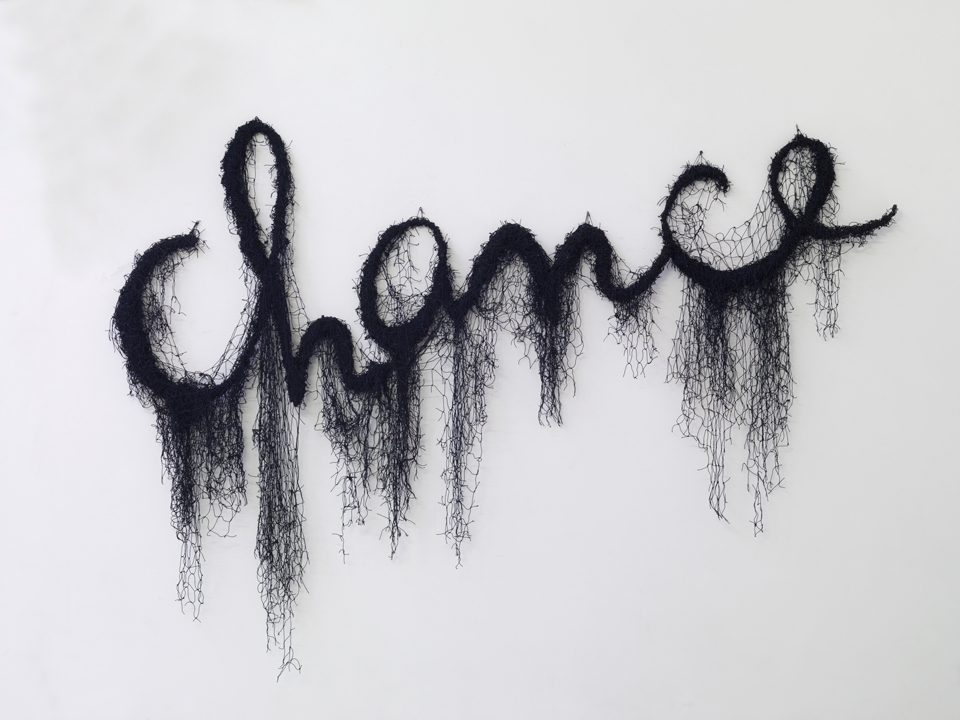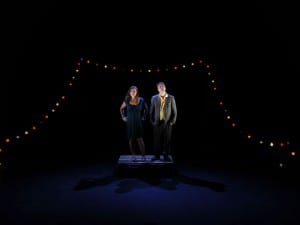Child’s play and the macabre world of Annette Messager appear in a retrospective exhibition at the Museum of Contemporary Art Australia, Sydney, this summer.
French artist Annette Messager’s (b. 1943) work ties together themes of play, memory, childhood, gender and loss, and is inescapably appealing and disturbing. She asks her audience to examine their secret, shadowy desires and inspirations, through her fantastical creations and installations. Curiously, though her work has been included in numerous major international group exhibitions and has been the focus of several solo exhibitions, she still manages to slip into obscurity in some countries. In Britain, it was only with the 2009 Hayward Gallery, London, show Annette Messager: The Messengers, that she came to mainstream prominence. This summer’s retrospective shown at the Museum of Contemporary Art Australia will do the same. Bringing together over 40 years of Messager’s installations, books, photographs, drawings and sculptures, the exhibition curated by Rachel Kent will present a thematic grouping of her creations to the Australian public.
Messager was born in Northern France but moved to Paris to study at the École des Arts Décoratifs during the early 1960s. The events of May 1968, a political, cultural, and sexual revolution, which began at Université Paris Ouest Nanterre La Défense, had a direct effect and bearing on her subsequent work and practice. The social changes that resulted from the protests and riots paved the way for a freedom of expression hitherto unseen in France and a breaking down of prevailing social, political and artistic hierarchies. The feminist movement became critical to the recognition of female practitioners but Messager hesitates to define herself as a feminist: she is an artist.
Very early on in her career she created and adopted two distinct personas: “Annette Messager Collectionneuse” (Annette Messager, collector) and “Annette Messager Artiste” (Annette Messager, artist). She developed these identities to situate herself in what she considered devalued territory: the arena of being a woman artist. As Annette Messager, Collectionneuse, she produced a series of 56 album-collections, consisting of photobooks and scrapbooks. Each work focused on a different theme or idea, typically around the role and representation of women in society. There is a violence and anger that weaves through some of these collections, often controversially as with Les Enfants aux yeux rayés, (Children with their eyes scratched out) no 3 (1971-1972). Constructed from visuals of babies and children with their eyes scratched out, the piece appears to direct anger towards the “child”. This is not her intention, but it illustrates Messager’s anger towards the expectation of young women to have children, to be driven purely by a maternal instinct. With Les Tortures Volontaires (The Voluntary Tortures) no 18 (1972), she focused on the extremes females go to achieve the “ideal”. Consisting of 81 images reproduced from beauty magazines, the work depicts various methods of self-improvement or “voluntary tortures” in the pursuit of beauty. As Rachel Kent, curator at MAC, points out, these “voluntary tortures” are not just directed at women as some of the images also depict men, signifying that this obsession with aesthetics is not gender-specific.
The tragedy of the female experience, if one would define it as a tragedy, is this pressure and expectation of the “body beautiful”. Particularly in art, the feminine form has historically been presented as an idealised shape. It was not until the early 1960s that this prevailing method of depiction was broken down with artists such as Yoko Ono, Carolee Schneemann, Gina Pane, and Yvonne Rainer, who worked with their own bodies and faces to present a new way of looking at and using the female “form” in art. Lucy Lippard argues in The Pains and Pleasures of Rebirth: Women’s Body Art (1976) that many women artists of the period still shied away from using their own body as they didn’t want to appear narcissistic: “Because we are considered sex objects, it is taken for granted that any woman who presents her nude frame in public is doing so because she thinks she is beautiful.” Messager will often slip visuals of herself into her art, such as with the album collections, but she is less obvious about the use of her own body as well as representations of physique in general. Her work focuses on the experiences we put our figures through to achieve what is perceived to be “normal”. The influence of the Surrealists and Art Brut on Messager in this regard is quite significant, particularly the paintings of French artist Jean Dubuffet. His style of painting, which is naive and slightly primitive, particularly appealed to the artist.
Her interest in the theme or subject form is thus often more abstracted than literal. Kent says that through objects and materials she is evoking a presence of, rather than creating, actual portrait form: “Rather than resembling self-portraiture, these works consider the nature of personal identity and, in some instances, gender, so they form a parallel portrait – looking within but also beyond oneself.” This idea manifests itself in Messager’s installations such as Pénétration (Penetration) (1993-1994), in which stitched fabric replicas of organs hang suspended from the gallery ceiling by long threads. The inner body is transcribed into the outer space, but it is not isolated from the viewer. The movement of the observer through the display area interacts with the installation by shifting and changing the positions of these swinging organs.
This literal revealing of the inner body is repeated in Anatomie (Anatomy), (1995-1996), in which red and blue knitted sweaters are unraveled, the yarn stretched across the walls. Kent explains: “The kinks and crinkles of thread approximate veins and arteries […] this work responds to the AIDS crisis and the idea of the body unraveling itself, mutating and out of control.”
Through Messager’s career this theme of the inner / outer body and the dichotomy between pleasure and pain, has remained consistent if not become more emphatic. There is violence in the way Messager breaks down the body, a disregard for the perceived fragility of the corporeal form. With Mes Voeux (My Vows) (1988-1991), the figure is depicted in its component parts: by an image of an ear, a hand, lips. The photographs are suspended on strings in a sculptural assemblage that brings to mind ex-votos and devotional offerings. Yet the ambiguity of the component parts disturbs rather than satisfies: again, the gender depicted is unidentifiable; it remains an elusive construct.
The corporeal theme is more subtle in Maman, Histoire de sa robe verte (Mama, the story of her green dress) (1990). The artist places photographs of body parts and watercolours captioned by text (referencing moments from her mother’s life), between the layers of green satin and black mesh skirt. Forming part of a larger collection of work, the Histoire des Robes (The Story of Dresses) from 1990, each dress “creates” its own narrative through the accompanying photographs, drawings and paintings. The dresses are placed within vitrines or frames in a very fetishistic manner: the viewer is closed off from the object, which has now been elevated from artwork to reliquary. Though raised by atheist parents, Messager would visit the churches of Berck-sur-Mer as a child, fascinated by the ritualism of the faith and the ornate, physical architecture of the buildings. This fascination plays out in the Histoire des Robes, through the use of reliquary-like presentation boxes, and in the presentation of the photographs of Mes Voeux (My Vows).
Messager has always turned away from using traditional art materials in her output, instead utilising everyday items and found materials, the use of fabric, netting and thread being the most prevalent in her practice and carried through her oeuvre from the beginning. Her participation in a wool-themed exhibition at Galerie Germain in Paris in 1971, for which she exhibited a small stuffed sparrow clad in a knitted covering, paved the way for a career focused on two particular mediums: taxidermy and the use of fabric. The series Le Repos des pensionnaires (Boarders at Rest) (1971-1972), formed of a collection of small taxidermy birds, dressed in hand-knitted outfits or coverings, resulted from the Paris exhibition. In much the same way that a child will innocently play with animals, Messager does as well: the childish element of their simple adornment, an act of beautifying the dead, or perhaps comforting the dead? The impact of Messager’s youth, growing up in Berck-sur-Mer, which is known for its large convalescent population, shows up in this series through a growing fascination with the dead and the macabre.
The use of knitting and embroidery in her work is integral to the formation of narratives and Messager states (in an interview with Natasha Leoff): “Stitches, netting, knitting, embroidery and meshes. They are all in my vocabulary. I have written on walls but, these writings are difficult, if impossible to read; they are like knitted fabrics, meshes.” Traditionally identified as “female” activities, these skills are used by Messager to deconstruct the notion of gender-specificity. This disregard for gender differences became evident quite early in her career, with the hybrid forms of the Chimaeras that she created in the early 1980s. These slightly grotesque creatures theatrically inhabit the space, their disparate photographed and painted forms are suggestive of the body but in an exaggerated Frankenstein mode.
The Chimaeras and further explorations into re-fashioned forms led to her use of stuffed toys in the late 1980s. Taking the beloved objects of childhood play and placing a small framed photograph hung by string around each toy’s neck, she isolated them into an adult context. Titled Mes Petites Effigies (My Little Effigies) (1988), these objects would be installed on the wall by Messager with scrawled fragments of text below. The photographs, in black and white, of details of the human body, suggest a darker or perhaps a bleaker element. The toys are no longer available for play, but have become reminders of past childhood through these detailed images of an adult human body. This idea becomes more apparent with Histoire des petites effigies (Story of Little Effigies) (1990), in which small toys are piled together enclosed by a collection of framed collages of little items of clothing. The installation appears as a shrine to youthful play no longer allowed.
There is a deep relationship between childhood and adulthood in Messager’s work. Kent cites Casino, her work for the French pavilion at the 2005 Venice Biennale, as the work that most astutely embodies this. It takes as inspiration Carlo Collodi’s story of Pinocchio, the marionette who wants to become human. The Pinocchio we know is a fantastical, sanitised version: the original Pinocchio was actually killed off by Collodi due to his bad acts. With Casino, a three-part installation for which the artist won the Golden Lion Award, we see subtle references to the human body and therefore the change from wooden toy to human. Red silk fabric, suspended from the ceiling, shifts and moves as the viewer wanders through it: suggesting the motion of limbs and blood. Messager returns to and adapts the story with Pinocchio’s Ballad in Beaubourg, installed in 2007 at the Centre Pompidou. The small mobile model of Pinocchio lies beneath large, over-stuffed limbs and body parts. There is a sadness to this work; a reminder of the limits of human capabilities.
Messager’s latest output has completely shifted away from the use of colour: black netting, mesh, cones and rubber have become de rigueur. This strict use of black, the colour associated with death and funerals, comments on age, loss and deterioration. Untitled (2012), in which small black shapes and cones on the gallery floor are lit up by rotating lights, functions through the juxtaposition of light and darkness. A projected clock on the gallery wall continuously ticks away, time passing without comment. Kent describes it as a “consideration of mortality, and the juxtaposition of loss with hope. This work offers a unique insight into the artist’s world today.” This is the truth behind Messager’s work: we are constantly haunted by a pervasive sense of loss, whether it be the absence of our childhood, of play, beauty or youth.
Annette Messager: Motion / Emotion continues until 26 October, at the Museum of Contemporary Art Australia, Sydney. Further information on the exhibition can be found on the museum’s website www.mca.com.au.
Niamh Coghlan





